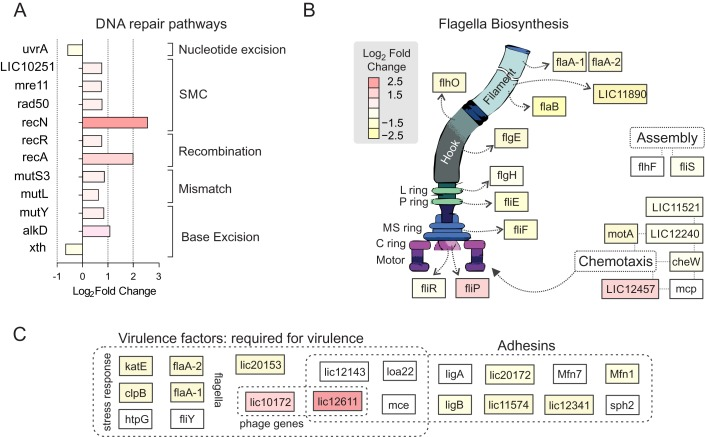Analysis of LexA binding sites and transcriptomics in response to genotoxic stress in Leptospira interrogans.
We determined the effects of DNA damage caused by ultraviolet radiation on gene expression in Leptospira interrogans using DNA microarrays. These data were integrated with DNA binding in vivo of LexA1, a regulator of the DNA damage response, assessed by chromatin immunoprecipitation and massively parallel DNA sequencing (ChIP-seq). In response to DNA damage, Leptospira induced expression of genes involved in DNA metabolism, in mobile genetic elements and defective prophages. The DNA repair genes involved in removal of photo-damage (e.g. nucleotide excision repair uvrABC, recombinases recBCD and resolvases ruvABC) were not induced. Genes involved in various metabolic pathways were down regulated, including genes involved in cell growth, RNA metabolism and the tricarboxylic acid cycle. From ChIP-seq data, we observed 24 LexA1 binding sites located throughout chromosome 1 and one binding site in chromosome 2. Expression of many, but not all, genes near those sites was increased following DNA damage. Binding sites were found as far as 550 bp upstream from the start codon, or 1 kb into the coding sequence. Our findings indicate that there is a shift in gene expression following DNA damage that represses genes involved in cell growth and virulence, and induces genes involved in mutagenesis and recombination.
Authors
Luciane Schons-Fonseca; Josefa B da Silva; Juliana S Milanez; Renan H Domingos; Janet L Smith; Helder I Nakaya; Alan D Grossman; Paulo L Ho; Renata M A da Costa
External link
Publication Year
Publication Journal
Associeted Project
Microbiology or Immunology
Lista de serviços
-
StructRNAfinder: an automated pipeline and web server for RNA families prediction.StructRNAfinder: an automated pipeline and web server for RNA families prediction.
-
CEMiTool: a Bioconductor package for performing comprehensive modular co-expression analyses.CEMiTool: a Bioconductor package for performing comprehensive modular co-expression analyses.
-
webCEMiTool: Co-expression Modular Analysis Made Easy.webCEMiTool: Co-expression Modular Analysis Made Easy.
-
Assessing the Impact of Sample Heterogeneity on Transcriptome Analysis of Human Diseases Using MDP Webtool.Assessing the Impact of Sample Heterogeneity on Transcriptome Analysis of Human Diseases Using MDP Webtool.
-
Predicting RNA Families in Nucleotide Sequences Using StructRNAfinder.Predicting RNA Families in Nucleotide Sequences Using StructRNAfinder.
-
OUTBREAK: a user-friendly georeferencing online tool for disease surveillance.OUTBREAK: a user-friendly georeferencing online tool for disease surveillance.
-
Noninvasive prenatal paternity determination using microhaplotypes: a pilot study.Noninvasive prenatal paternity determination using microhaplotypes: a pilot study.
-
Editorial: User-Friendly Tools Applied to Genetics or Systems Biology.Editorial: User-Friendly Tools Applied to Genetics or Systems Biology.
-
Automatic detection of the parasite Trypanosoma cruzi in blood smears using a machine learning approach applied to mobile phone imagesAutomatic detection of the parasite Trypanosoma cruzi in blood smears using a machine learning approach applied to mobile phone images
-
Tucuxi-BLAST: Enabling fast and accurate record linkage of large-scale health-related administrative databases through a DNA-encoded approachTucuxi-BLAST: Enabling fast and accurate record linkage of large-scale health-related administrative databases through a DNA-encoded approach
-
Ten quick tips for harnessing the power of ChatGPT in computational biologyTen quick tips for harnessing the power of ChatGPT in computational biology

